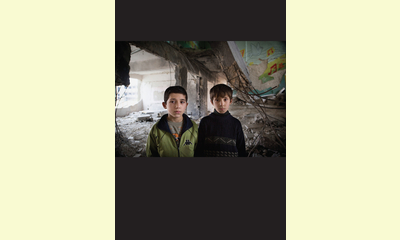|
|
Human Rights Watch Annual Report: Rights Struggles of 2013
an article by Kenneth Roth, Executive Director, Human Rights Watch (abridged)
Video: Human Rights Watch annual report
Looking back at human rights developments in 2013,
several themes stand out. The unchecked slaughter
of civilians in Syria elicited global horror and
outrage, but not enough to convince world leaders
to exert the pressure needed to stop it. That has
led some to lament the demise of the much-vaunted
“Responsibility to Protect” doctrine, which world
governments adopted less than a decade ago to
protect people facing mass atrocities. Yet it
turned out to be too soon to draft the epitaph for
R2P, as it is known, because toward the end of the
year it showed renewed vitality in several African
countries facing the threat of large-scale
atrocities: Central African Republic, South Sudan,
and the Democratic Republic of Congo.

Two boys stand in a school building damaged by government shelling in Aleppo, Syria, February 2013. © 2013 Nish Nalbandian/Redux
click on photo to enlarge
Democracy took a battering in several countries,
but not because those in power openly abandoned
it. Many leaders still feel great pressure to pay
lip service to democratic rule. But a number of
relatively new governments, including in Egypt and
Burma, settled for the most superficial forms—only
elections, or their own divining of majoritarian
preferences—without regard to the limits on
majorities that are essential to any real
democracy. This abusive majoritarianism lay behind
governmental efforts to suppress peaceful dissent,
restrict minorities, and enforce narrow visions of
cultural propriety. Yet in none of these cases did
the public take this abuse of democracy sitting
down.
Since September 11, 2001, efforts to combat
terrorism have also spawned human rights abuses.
The past year saw intensified public discussion
about two particular counterterrorism programs
used by the United States: global mass electronic
surveillance and targeted killings by aerial
drones. For years, Washington had avoided giving
clear legal justifications for these programs by
hiding behind the asserted needs of secrecy. That
strategy was undermined by whistleblower Edward
Snowden’s revelations about the surveillance
program, as well as by on-the-ground reporting of
civilian casualties in the targeted-killing
program. Both now face intense public scrutiny.
In the midst of all this upheaval, there were also
important advances in the international machinery
that helps to defend human rights. After a slow
and disappointing start, the United Nations Human
Rights Council seemed to come onto its own, most
recently with significant pressure applied to
North Korea and Sri Lanka. And two new
multinational treaties give hope for some of the
world’s most marginalized people: domestic workers
and artisanal miners poisoned by the unregulated
use of mercury.
In 2005, the world’s governments made an historic
pledge that if a national government failed to
stop mass atrocities, they would step in. The
international community has since invoked the R2P
doctrine successfully to spare lives, most notably
in Kenya in 2007-2008 and Côte d’Ivoire in 2011.
However, many governments criticized the doctrine
after NATO’s 2011 military intervention in Libya,
where NATO was widely perceived to have moved
beyond the protection of civilians to regime
change. The reaction poisoned the global debate
about how to respond to mass atrocities in Syria.
The utter failure to stop the slaughter of Syrian
civilians has raised concerns that the doctrine is
now unraveling. Yet that damning shortcoming
should not obscure several cases [mentioned above]
in 2013 in which R2P showed considerable vibrancy.
. .
( Click here for a version in Spanish or here for a version in French.)
|








|
DISCUSSION
Question(s) related to this article:
What is the state of human rights in the world today?,
* * * * *
Latest reader comment:
Each year we get overviews of the state of human rights in the world from Amnesty International and Human Rights Watch.

|
|









